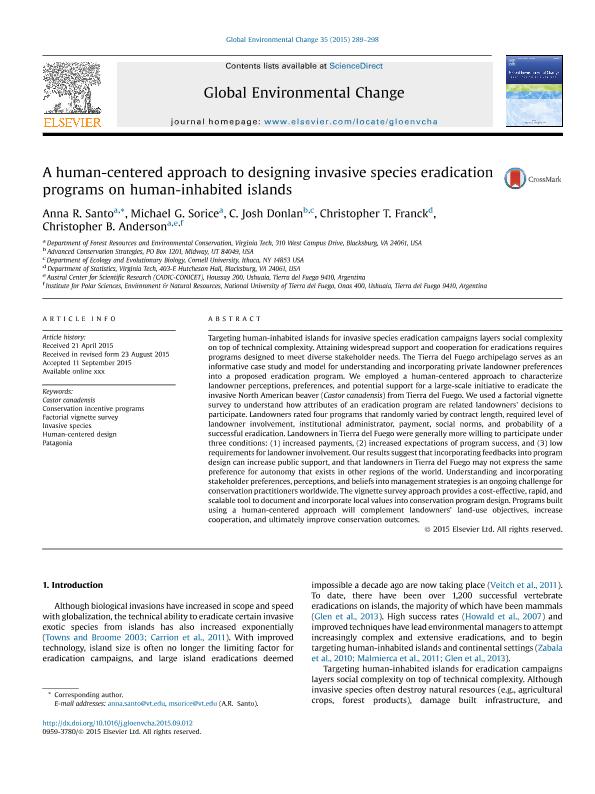Artículo
A human-centered approach to designing invasive species eradication programs on human-inhabited islands
Santo, Anna; Sorice, Michael G.; Donlan, C. Josh; Franck, Christopher T.; Anderson, Christopher Brian

Fecha de publicación:
10/2015
Editorial:
Elsevier
Revista:
Global Environmental Change
ISSN:
0959-3780
Idioma:
Inglés
Tipo de recurso:
Artículo publicado
Clasificación temática:
Resumen
Targeting human-inhabited islands for invasive species eradication campaigns layers social complexity on top of technical complexity. Attaining widespread support and cooperation for eradications requires programs designed to meet diverse stakeholder needs. The Tierra del Fuego archipelago serves as an informative case study and model for understanding and incorporating private landowner preferences into a proposed eradication program. We employed a human-centered approach to characterize landowner perceptions, preferences, and potential support for a large-scale initiative to eradicate the invasive North American beaver (Castor canadensis) from Tierra del Fuego. We used a factorial vignette survey to understand how attributes of an eradication program are related landowners' decisions to participate. Landowners rated four programs that randomly varied by contract length, required level of landowner involvement, institutional administrator, payment, social norms, and probability of a successful eradication. Landowners in Tierra del Fuego were generally more willing to participate under three conditions: (1) increased payments, (2) increased expectations of program success, and (3) low requirements for landowner involvement. Our results suggest that incorporating feedbacks into program design can increase public support, and that landowners in Tierra del Fuego may not express the same preference for autonomy that exists in other regions of the world. Understanding and incorporating stakeholder preferences, perceptions, and beliefs into management strategies is an ongoing challenge for conservation practitioners worldwide. The vignette survey approach provides a cost-effective, rapid, and scalable tool to document and incorporate local values into conservation program design. Programs built using a human-centered approach will complement landowners’ land-use objectives, increase cooperation, and ultimately improve conservation outcomes.
Archivos asociados
Licencia
Identificadores
Colecciones
Articulos(CADIC)
Articulos de CENTRO AUSTRAL DE INVESTIGACIONES CIENTIFICAS
Articulos de CENTRO AUSTRAL DE INVESTIGACIONES CIENTIFICAS
Articulos(SEDE CENTRAL)
Articulos de SEDE CENTRAL
Articulos de SEDE CENTRAL
Citación
Santo, Anna; Sorice, Michael G.; Donlan, C. Josh; Franck, Christopher T.; Anderson, Christopher Brian; A human-centered approach to designing invasive species eradication programs on human-inhabited islands; Elsevier; Global Environmental Change; 35; 10-2015; 289-298
Compartir
Altmétricas



